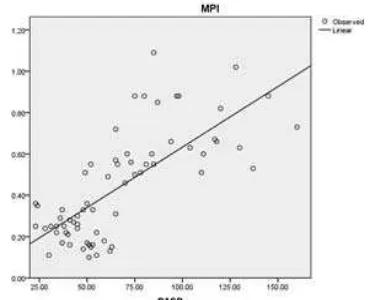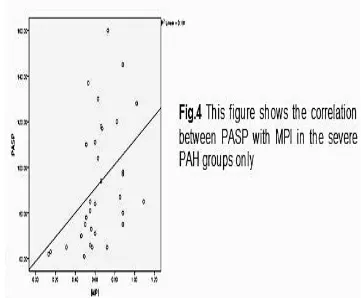Bagaswoto et al., 2016
14
Correlation Between Right Ventricular Function Using Myocardial Performance Index
(Tei Index) with Pulmonary Arterial Hypertension Severity in Patient with Atrial Septal Defect
Hendry Purnasidha Bagaswoto, Dyah Wulan Anggrahini, Hasanah Mumpuni, Lucia Krisdinarti
Department of Cardiology and Vascular Medicine
Faculty of Medicine Universitas Gadjah Mada - Dr. Sardjito General Hospital, Yogyakarta, Indonesia
ABSTRACT
Background: Right ventricular (RV) volume overload that occurs in patients with atrial septal defect (ASD) could lead to the development of pulmonary arterial hypertension (PAH). RV function has been found depressed in some patients with PAH. Myocardial performance index (MPI) is one of methods to assess RV function. The aim of this study was to assess correlation between RV function using RV-MPI with PAH severity in patients with ASD.
Methods: We conducted a cross sectional study between July 2012-July 2013. We enrolled 67 patients with secundum type ASD. RV-MPI, defi ned as the sum of isovolumic relaxation time and isovolumic contraction time derived by ejection time, was measured from tricuspid infl ow and RV outfl ow. The normal range is 0.28-0.32. Pulmonary artery systolic pressure (PASP) was measured from echocardiography.
Results: There were 67 patients (54 women) with mean age was 38.01±14.29 years (11.9% with no PAH, 11.9% mild PAH, 26.9% moderate PAH and 49.3% severe PAH). The mean PASP was 67.16±32.33 mmHg and mean MPI was 0.44±0.25. We found signifi cant correlation between PASP and MPI (r=0.73; p=0.000). In addition, we classifi ed the PAH severity based on PASP and there was signifi cant differences of MPI between groups (no PAH, MPI 0.25±0.07; mild PAH 0.24±0.05; moderate PAH 0.24±0.12; severe PAH 0.63±0.21; p=0.000). Furthermore, in severe PAH group, the correlation between PASP and MPI remain signifi cant (r=0.42; p<0.05).
Conclusion: These result demonstrate a correlation between PAH severity and MPI in patients with ASD. Specifi cally, RV function found decreased in ASD patients with severe PAH.
Keyword: Myocardial performance index (Tei index) -- Pulmonary arterial hypertension -- Right ventricular function -- Atrial septal defect
BACKGROUND
Pulmonary hypertension complicates the course of many children and adults with congenital heart diseases (CHD). The increase in pulmonary pressure associated with CHD is either secondary to increased pulmonary blood fl ow or to increased post-capillary pressures.1
Right ventricular (RV) volume overload occurs in patients with signifi cant atrial septal defect (ASD) shunt. This condition could lead to the development of pulmonary arterial hypertension (PAH). RV function has been found depressed in some patients with PAH.2
Assessing the function of the morphological RV is challenging because of its complex anatomy. Diffi culties are compounded by irregularities in the ventricular cavities and abnormalities in wall motion in patients with congenital heart lesions.
The complex shape of the RV makes quantifi cation diffi cult.3
Myocardial performance index (MPI) is one of index that linked with PAH.4 The aim of this study was to assess correlation between RV function and PAH severity in patients with ASD using MPI (Tei index).
METHODS
Acta Cardiologia Indonesiana (Vol 2 No. 1): 14-17
15 RESULTS
There were 67 patients (54 women) with mean age was 38.01±14.29 years (11.9% with no PAH, 11.9% mild PAH, 26.9% moderate PAH and 49.3% severe PAH) (Table 1). The mean PASP was 67.16±32.33 mmHg and mean MPI was 0.44±0.25. We found signifi cant correlation between PASP and MPI (r=0.73; p=0.000) (Figure 2).
Fig 2. This fi gure shows the positive correlation between PASP and MPI
In addition, we classifi ed the PAH severity based on PASP and there was significant differences of MPI between groups (no PAH,
MPI 0.25±0.07; mild PAH 0.24±0.05; moderate PAH 0.24±0.12; severe PAH 0.63±0.21; p=0.000) (Figure 3). Furthermore, in severe PAH group, the correlation between PASP and MPI remain signifi cant (r=0.42; p<0.05) (Figure 4).
Fig 3. Signifi cant differences of MPI in severe PAH as compare with other groups
DISCUSSION
Atrial septal defect (ASD) is one of the most common congenital heart defects, accounting for 30-40% of congenital heart disease in the adult, with a prevalence of 2.8 to 8.8 per 1000 live births, and is more frequent in women by a ratio of 2:1. Ostium secundum ASD accounts for 75% of all ASD, while ostium primum and sinus venosus account for 15% and 10% respectively.5
Fig 1. Measurement of RV-MPI
Bagaswoto et al., 2016
16 Pulmonary arterial hypertension frequently arises in patients with congenital heart disease. The vast majority present with congenital cardiac shunts. Initially these may manifest as left-to-right (i.e. systemic-to-pulmonary) shunts. The natural history of disease progression involves vascular remodeling and dysfunction that lead to increased pulmonary vascular resistance and, fi nally, to the development of Eisenmenger’s syndrome, which is the most advanced form. The anatomical, pathological and structural abnormalities occurring in the pulmonary circulation of these patients are, to some extent, similar to those observed in other forms of PAH.1
Fig 4. Correlation between PASP with MPI in severe PAH groups
Abnormally high afterload, or systolic wall stress, may result in depression of ventricular systolic performance. Right ventricular function has been found depressed in some patients with PAH. This depression of systolic performance is probably the direct result of increased afterload, since normal RV contractility has been found in patients with pulmonary hypertension and RV failure. Furthermore, RV function often improves after relief of abnormal afterload. When PAH occurs in the setting of a signifi cant left-to-right shunt due to ASD, abnormally high RV afterload and preload may coexist.2
Right ventricular function is an important predictor of morbidity and mortality in patients with heart failure and pulmonary hypertension. With thin and compliant walls accustomed to the low pressures and resistance of the pulmonary vasculature, the RV first increases in size and hypertrophies to overcome elevated pulmonary vascular resistance (PVR). Patients with longstanding pulmonary vascular disease
or secondary pulmonary hypertension initially develop RV hypertrophy with normalization of RV volume, but this is eventually followed by progressive dilatation and deterioration of systolic and diastolic function.6
The MPI, also known as Tei index, is a global estimate of both systolic and diastolic function of the right ventricle. It is based on the relationship between ejection and non ejection work of the heart. The MPI is defi ned as the ratio of isovolumic time divided by ET, or [(IVRT + IVCT)/ET].4
RV Tei-index was correlated with mean PAP and PVR at enrollment, and the changes in RV Tei-index were correlated with the changes in mean PAP and PVR during the clinical course of PAH by medical treatment. In PAH patients, RV Tei-index was strongly correlated with clinical and pulmonary hemodynamic variables, especially PVR, and the improvement in RV Tei-index was correlated with the improve-ment in afterload by PAH-specific therapy. These findings suggest that the measurement of RV Tei-index is of great clinical utility for predicting the disease severity of PAH and determining the changes in the patient’s hemodynamics.7
CONCLUSIONS
These result demonstrate a correlation between PAH severity and MPI in patients with ASD. Specifi cally, RV function found decreased in ASD patients with severe PAH.
REFERENCES
B e g h e t t i M a n d Ti s s o t C . P u l m o n a r y 1.
Hypertension in Congenital Shunts. Revista Española de Cardiología 2010; 63(10): 1179-93.
Konstam MA, Idoine J, Wynne J, Grossman 2.
W, Cohn L. Right Ventricular Function in Adults With Pulmonary Hypertension With and Without Atrial Septal Defect. The American Journal of Cardiology 1983; volume 51. Ding J, Ma G, Huang Y, Yang R, Lu F. 3.
Usefulness of Myocardial Performance Index for Assessing Right Ventricular Function After Percutaneous Closure of Atrial Septal Defect. Journal of Geriatric Cardiology 2007;4: 220-224.
Rudski LG, Solomon SD, Chandrasekaran 4.
Acta Cardiologia Indonesiana (Vol 2 No. 1): 14-17
17 Assessment of the Right Heart in Adults: A Report from the American Society of Echocardiography. Journal of the American Society of Echocardiography 2010;23: 685-713.
Providencia R, Botelho A, Quintal N, Costa M, 5.
Santos AP. Pulmonary hypertension in patients with ostium secundum atrial septal defect – is it related to echocardiographic complexity? Rev Port Cardiol 2009; 28(10): 1087-1096.
Karas MG, Kizer JR. Echocardiographic 6.
Assessment of the Right Ventricle and Associated Hemodynamics. Progress in Cardiovascular Diseases 2012; 55: 144-160. Ogihara Y, Yamada N, Dohi K, Matsuda A, 7.

